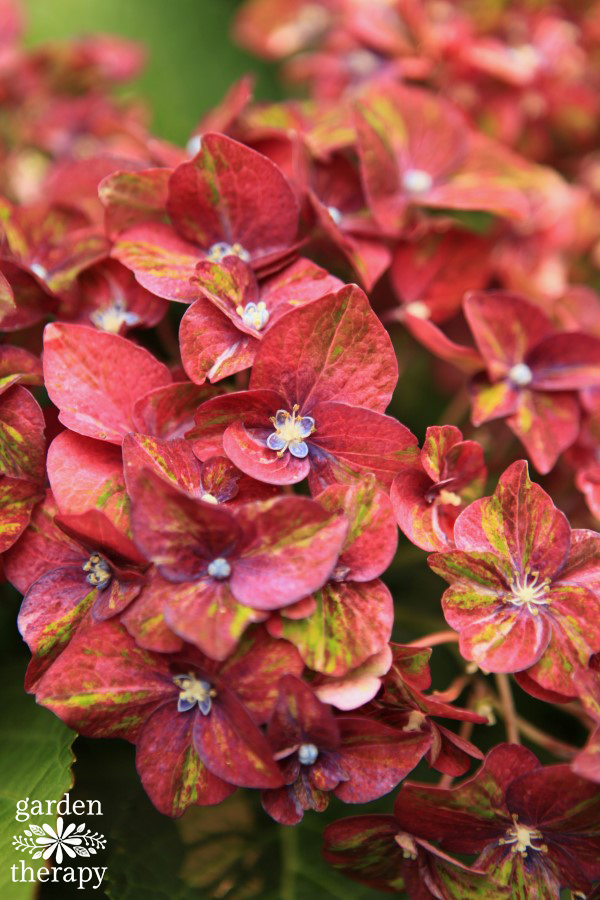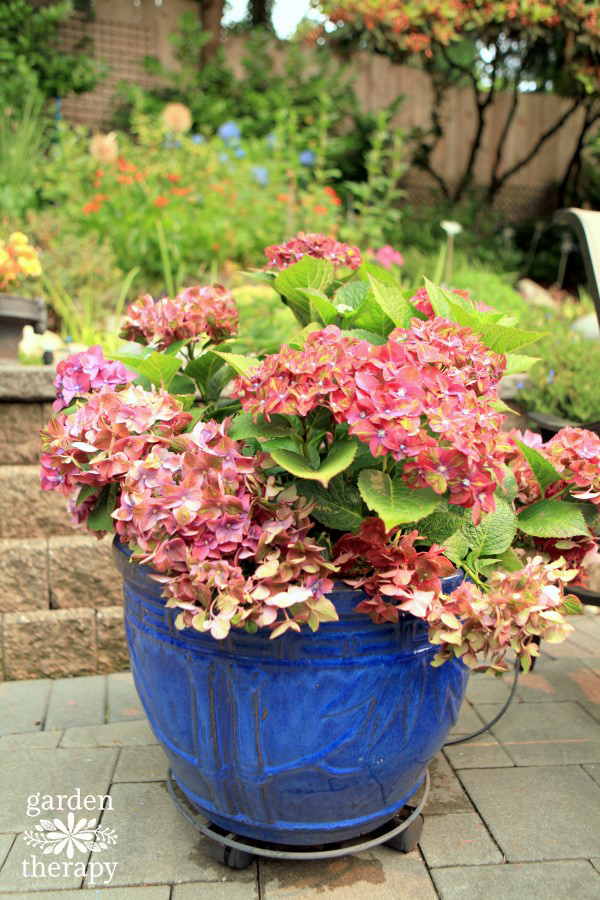What’s not to love about hydrangeas? These showy shrubs are the delight of summer blooms. They are long-living shrubs that bloom most of the summer and well into fall. Here is a guide to all things hydrangea: a description of the different types, how to change their color, drying projects, and how to properly manage hydrangea care!

Type of Hydrangeas
Most Hydrangeas prefer moist, rich soil, and part sun /part shade locations. They generally like a bit of morning sun and cooling shade in the afternoon to perform best and stay healthy.
Several species (and many, many varieties of these species) of the hydrangea genus are commonly seen in garden centers and florist shops. I have four types representing three species in my landscape: ‘Endless Summer’ bigleaf hydrangea, ‘Bluebird’ lacecap compact hydrangea, ‘Tardiva’ hardy hydrangea, and ‘Alice’ oakleaf hydrangea.
Bigleaf Hydrangea (Hydrangea macrophylla)
Bigleaf hydrangea is a spring bloomer, and perhaps the most widely sought species. They may have either round or flat flower clusters in shades of white, red, pink, blue, purple, and sometimes red. The big round bloomers are called “mopheads” and those with flat blooms are called “lacecaps.”
Mountain hydrangea (Hydrangea serrata)
Mountain hydrangea is extremely similar to macrophylla but is smaller and more cold hardy. It is broad with large heads of pink or blue flowers in summer and autumn.
Hardy Hydrangea (Hydrangea paniculata)
These pretty hydrangeas bloom in the summer. The long cone-shaped blooms change in color from light green to white to pink or red as they mature.
Oakleaf Hydrangea (Hydrangea quercifolia)
The Oakleaf hydrangea is famous for its large, deep green leaves that persist far into autumn and for its displays of fall shades of orange, red and maroon before dormancy. Oakleaf hydrangea bears its white panicles of blooms in early summer.
Other Tyles of Hydrangeas
- Climbing Hydrangeas such as Decumaria barbata and Hydrangea petiolaris are vines which behave politely as they climb walls, fences, and pergolas. Unlike wisteria they are relatively tame and easy to prune.
- Wild Hydrangea, (Hydrangea arborescens ‘Annabelle’), is a loose—and wide—branched shrub that likes moist soil or rocky slopes.
- Rough-Leaved Hydrangea (Hydrangea aspera) has rough leaves and broad, flat flower heads. You can even get ones with purple foliage like this ‘Plum Passion’ from Monrovia.

Pruning Hydrangeas
Hydrangeas don’t need to be pruned, but some varieties will give you a better show if you do give them a cut. The most important things to know for pruning hydrangeas successfully is what kind of hydrangea you have and when to cut.
Hydrangeas that bloom on old wood (last season’s stems rather than this season’s) should only be pruned after flowering. Hydrangeas that bloom on new wood can be pruned in the fall before winter dormancy or in spring as soon as you can see new growth. At this time of year, you can prune back the whole plant for bigger flowers, thin them out, or shape them freely.
Despite all of these recommendations, you should always follow the 4 D’s of pruning. That is, you can safely remove any damaged, diseased, dead, or dying plant material at any time of the year. In fact, it’s encouraged for the best health of your plant.
Here are a few more resources on pruning:
Learn How to Prune like a Pro! Pruning 101
Want to Know WHEN to Prune? This Will Answer All of Your Questions!
The Art of Espalier: Growing Fruit Trees in Small Spaces

Hydrangea Propagation
When doing hydrangea propagation, the best branches to work with are relatively thick (one and a half times the thickness of a pencil), a little green (but not brand new shoots), with no flower buds.
Cut the top six inches of the branch, making the cut two inches or so below the leaf node (this is the junction where a leaf sprouts or sprouted from the branch).
Remove all except the top two leaves. Cut the top two leaves in half to reduce the loss of water through transpiration. Dip the base of the cutting into rooting hormone (which isn’t absolutely necessary) then put the cutting into a sterile seedling mix. See how to do it here.

How to Change Hydrangea Color
Love your hydrangea blooms but want to change up their color? Many hydrangeas will go through a slight color change when transplanted due to the adjustment to their new soil when you first bring them home.
But if you really want to shake things up, this simple little soil hack will help you learn how to change hydrangea colors!
Drying Hydrangeas
It’s not that hard to dry hydrangea flowers and keep their color! Here is how:
Thank you to Monrovia for providing some of the photos for this article and to VanRubin Gardens, the personal garden of Jeffery Rubin in West Vancouver, BC, for a tour of his gorgeous garden.

More Plant Care Guides:
- The Essential Guide to Growing Hostas
- Growing Happy + Healthy Succulents – The Essential Guide
- The Essential Guide to Growing Lavender
- Rosemary Care, Use, and Healing Benefits
- Herbal Guide to Oregano






My hydrangea leaves are not dark green, it is more like a lemon green and seems to be curling. Can you help please? Thank you.
Hi, My Hydrangeas don’t bloom. When I first bought they were in bloom. Are there any tricks as to what I might try? Thank you, Diane
Here ya go! https://gardentherapy.ca/why-is-my-hydrangea-not-blooming/
Do hydrangea wilt from too much water as well as too little